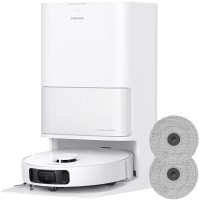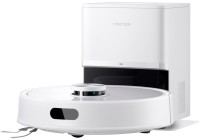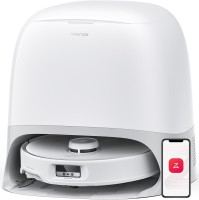Пилососи: Відповіді на найчастіші запитання
Ми незалежно перевіряємо товари та технології, які рекомендуємо.

Якщо ви готові до самостійного вибору моделі та хочете відсортувати актуальний асортимент за цінами, брендами, типами та різними технічними параметрами, то рекомендуємо скористатися загальним каталогом пилососів.
Чим відрізняється потужність пилососа від потужності всмоктування?
Показники потужності зазвичай вважаються одними з ключових технічних характеристик багатьох побутових електроприладів. Але коли йдеться про пилососи, то тут часто виникає плутанина. Вся справа в тому, що у цих пристроїв виділяють кілька параметрів потужності, а саме:
- потужність споживання. Даний показник вимірюється у ватах (Вт) і відображає кількість енергії, яку витрачає в роботі двигун пилососа. Ця характеристика прямо визначає споживання електроенергії за одиницю часу (тобто економічність чи, навпаки, марнотратність приладу). Ще вона, як правило, прямо впливає на шумність, а ось із продуктивністю (швидкістю прибирання, ефективністю поглинання пилу) можуть бути нюанси. Тобто умовний 2000-ватний пилосос не обов'язково справлятиметься зі своїми задачами краще, ніж аналог на 1600 Вт. Так, виробники роблять пилососи потужнішими саме з метою підвищення результативності роботи, але ККД у моторів може відрізнятися;
- потужність всмоктування. Цей параметр також вимірюється у Вт (зрідка фігурують «аеровати»). Він характеризує роботу вакуумної системи пилососа та відображає її здатність втягувати повітря. Даний показник прямо впливає на те, як добре модель поглинає пил та інше сміття, тобто чим вище значення, тим продуктивніше має бути прибирання. На цю характеристику і варто орієнтуватися в першу чергу при покупці, а не на потужність споживання. Потужність всмоктування залежить від двох складових – розрідження, що створюється вакуумною системою всередині корпусу, і повітряного потоку. На останній прямо впливають різні конструктивні аспекти, у тому числі діаметр шланга (і трубок), наявність або відсутність перешкод на шляху повітря тощо.
Потужність споживання побутових пилососів зазвичай варіюється від 500 до 2000 Вт. Менше показники у роботів, вертикальних і ручних моделей, а, як правило, більші — у будівельних (промислових) приладів. Потужність всмоктування у традиційних пилососів найчастіше знаходиться в діапазоні від 150 до 400 Вт. На практиці найчастіше співвідношення між цими параметрами потужності знаходиться в діапазоні від 3:1 до 6:1: умовно при споживанні двигуном 1500 Вт всмоктування досягає 300 Вт (5:1). Нижче наведене співвідношення потужностей популярних пилососів різних типів:
| Модель | Тип | Потужність споживання, Вт | Потужність всмоктування, Вт |
|---|---|---|---|
| Thomas MultiCyclone Pro 14 | звичайний | 1800 | 300 |
| Samsung VCC-45W0S36 | звичайний | 700 | 190 |
| Gorenje VCE 01 SFAWR | звичайний | 850 | 160 |
| Samsung Jet 75 VS-20B75ADR5 | вертикальний | 550 | 200 |
| Dreame R20 | вертикальний | 570 | 190 |
| Gorenje MVC 72 HGA | ручний | 70 | 10 |
| Samsung Jet Bot AI+ VR-50T95735W | робот | 170 | 30 |
Серед показників, що відображають ефективність роботи пилососів, останнім часом іноді вказується ще одна характеристика — сила всмоктування або тяга. Даний параметр вимірюється в Паскалях (Па), відображає розрідження, що створюється, тобто негативний тиск (а якщо ще простіше — вакуумне зусилля) на робочій насадці. Тяга все ж таки не така інформативна для користувача на тлі потужності всмоктування, адже та враховує і розрідження, і об'єми повітряного потоку. Чим вище сила в Па, тим краще прилад повинен видаляти сміття зі складних поверхонь, на кшталт оббивки або килимів з ворсом. Але разом з тим підвищення тяги при слабкому повітряному потоці (а це актуально для роботів початкового класу і багатьох ручних моделей) знижує результати прибирання на гладких покриттях – плитці, лінолеумі тощо.

Зазначимо, що силу всмоктування наводять далеко не завжди. Найчастіше її надають для малопотужних моделей. Бренди в даному разі серед іншого переслідують і маркетингову мету, адже значення в 3000 Па виглядає якось солідніше, ніж потужність всмоктування в 40 Вт. Щоправда, є й винятки з правил, але якщо йдеться про побутові (традиційні) пилососи, то у продуктивних рішень тяга наближається до значення 20 000 Па, а то й більше.
В цілому, якщо для пилососа надані всі три описані вище параметри, то краще орієнтуватися саме на потужність всмоктування, а тягою в Паскалях можна знехтувати.
Якої потужності має бути пилосос?
Насамперед орієнтуватися потрібно саме на потужність всмоктування, а не показники споживання електроенергії. Оптимальні значення прямо залежать від типу приладу та задач, що переслідуються. Так, найпростіше розібратися з критеріями потужності для традиційних побутових пилососів. Ось основні рекомендації:
- для твердих підлог – плитки, лінолеуму, ламінату, паркету – цілком достатньо значення до 250-300 Вт;
- для догляду за ковроліном та м'якими покриттями для підлоги з коротким ворсом підходять пилососи з потужністю всмоктування від 350 до 400 Вт;
- Для ворсистих килимів та ефективного очищення м'яких меблів варто розглядати моделі з показником від 400-450 Вт. Ці пилососи гарантують справді сильну тягу.
Нормою для вертикальних пилососів можна вважати діапазон від 100 до 300 Вт. Зрозуміло, що чим вище буде значення у конкретної моделі, тим краще, хоча найчастіше в прямій залежності знаходиться і цінник. У акумуляторних (у тому числі ручних) пилососів і роботів потужність всмоктування рідко перевищує кілька десятків Вт, але і їх призначення відрізняється від звичайних моделей. Вони служать для точкового прибирання, підтримання чистоти, збору крихт, різних вузькопрофільних задач. І тут треба орієнтуватися не так на потужнісні параметри, як на комплектацію насадок, рекомендації щодо застосування, відгуки користувачів тощо.
Якої потужності має бути пилосос для килима?

Для ефективного очищення килимів та інших ворсистих покриттів для підлоги найкраще підходять пилососи з великою потужністю всмоктування. Фактично можна дотримуватись принципу «чим вище, тим краще». Якщо ближче до конкретики, то варто відштовхуватися від типу килима:
- якщо йдеться про ковролін (або інші покриття з низькою довжиною ворсу), то підійдуть пилососи від 350 Вт і більше;
- якщо у вас довговорсові килими, краще орієнтуватися на моделі з тягою не нижче 400-450 Вт. Таких показників потужності вистачить, щоб «дістати» пил, крихти та інші забруднення безпосередньо з основи покриття.
Якщо килимів у вас багато, то не зайвим буде закласти і запас потужністю близько 15%. Справа в тому, що нерідко заявлені паспортні дані (характеристики, вказані в інструкції або на офіційному сайті виробника) – це не номінальний, а максимальний параметр. Що це означає? Таку потужність прилад підтримує до 2 хвилин після запуску, а потім вона трохи просідає (на 10-15%, а часом і сильніше). Так, якщо для моделі вказано 400 Вт, то цілком імовірно, що її номінальна потужність нижче (близько 340 Вт), а цього для килима з довгим ворсом може бути замало.
Крім потужності потрібно враховувати і пропоновані комплектні насадки. Зазвичай на килимах застосовують комбіновану щітку, яка має спеціальну позицію для м'яких підлогових покриттів. Але значно ефективніше з їх очищенням справляються моделі з турбощіткою в комплекті.
Яка потужність має бути у гарного бездротового пилососа?
Акумуляторний пилосос за інших рівних умов програє мережевому аналогу за потужністю. Для багатьох бездротових моделей параметри всмоктування не вказуються. Це побічно свідчить, що вони низькі і лише відлякають потенційних покупців. Відповідно, краще розглядати для покупки пилососи, для яких потужність всмоктування все ж таки вказана.
За наявності в комплектації звичайної або електротурбощітки орієнтуватися можна на наступні цифри:
- до 60 Вт – моделі, які підійдуть для локальних робіт або щоденної підтримки чистоти. Можуть бути альтернативою електровіника ;
- від 60 до 100 Вт – достатня потужність для простих задач та приміщень з малою запиленістю;
- від 100 до 150 Вт – збалансовані бездротові пилососи для прибирання твердих підлогових покриттів;
- вище 150 Вт – досить універсальні помічники, серед яких є моделі, готові навіть до ретельного очищення м'яких меблів або ворсистих покриттів для підлоги. Серед останніх можна виділити, наприклад, JIMMY HW10 Pro або Dyson Gen5detect Absolute.
Якщо в розпорядженні буде тільки одна акумуляторна модель, то розумно і далекоглядно брати досить сильне рішення. Якщо шукаєте бездротовий прилад на додаток до звичайного, то доцільніше орієнтуватися на задачі, які він повинен виконувати — переплачувати за екстра вати навряд чи варто.

Що краще вертикальний пилосос чи звичайний?
Сьогодні звичайні побутові пилососи вже не є безальтернативними рішеннями для прибирання. Як конкурента можна розглядати вертикальні моделі. Який варіант підійде вам? Відштовхуватися варто від сильних та слабких сторін кожного типу приладів. Плюси звичайних пилососів:
- Висока потужність та відповідно ефективність поглинання різноманітних забруднень.
- Місткий пилозбірник, який не потрібно спорожнювати під час прибирання.
- Можливість дістатися до найважчих місць, включаючи під ліжками та шафами. Висока універсальність: в асортименті є прилади з великою кількістю насадок, підтримкою вологого прибирання, повноцінного миття підлог тощо.
Мінуси звичайних моделей:
- Громіздкі розміри, що часом ускладнюють і експлуатацію, і зберігання.
- Робота лише від електромережі.
Тепер розглянемо переваги та недоліки вертикальних пилососів.
Плюси вертикальних пилососів:
- Компактність і відносно невелика вага: підвищують зручність при прибиранні, спрощують зберігання.
- Маневреність, завдяки якій, наприклад, простіше пилососити на сходових прольотах, у стиснених умовах (на полицях, у заставлених меблями частинах кімнати).
- Швидка готовність до роботи: взяли та розпочали експлуатацію.
- Зустрічаються різні рішення з погляду живлення — мережеві та акумуляторні.
- Зустрічається чимало моделей-трансформерів – вертикальних з портативним блоком, який можна використовувати як ручний пилосос для локального прибирання або прибирання в автомобілі.
Мінуси вертикальних рішень:
- Поступаються за потужністю та місткістю пилозбірника.
- Гірше підходять для прибирання під низькими меблями (хоча сьогодні і тут є рішення – моделі зі трубкою, що згинається).
- Не варіативні в аспекті пилозбірника, що використовується — понад 90% комплектуються циклонним контейнером.

Підведемо підсумок. Звичайний пилосос краще підходить для сценарію з щотижневим прибиранням усієї квартири або приватного будинку. Висока потужність всмоктування робить ці моделі ідеальними для сімей з домашніми тваринами, великою кількістю килимів та інших ворсистих покриттів. Вертикальні пилососи – це гарний вибір для підтримки чистоти, регулярних коротких прибирань, швидкого наведення порядку на кухні (після приготування або випадкового розсипання продуктів). За великим рахунком, ці два види приладів не виключають, а можуть доповнювати один одного.
Який пилосос краще від акумулятора чи від мережі?
Сьогодні пропонується великий вибір як мережевих, так і акумуляторних (бездротових) пилососів. Щоб зрозуміти, який з них підходить саме вам, варто розібратися в плюсах та мінусах кожного з різновидів.
Почнемо зі стаціонарних рішень. Плюси пилососів з живленням від мережі :
- Майже необмежений час роботи.
- Вище стеля за потужністю всмоктування, а значить і можливість більш якісної та швидкої боротьби із забрудненнями.
- Ширша функціональність, включаючи підтримку вологого прибирання.
Мінуси :
- Залежність від розеток.
- Менша маневреність та радіус дії.
- Частіше більше вага та габарити.

Переходимо до бездротових пилососів. До їх сильних сторін належать :
- Компактність та досить легка вага.
- Висока маневреність, яка важлива в стиснених житлових умовах, в інших обставинах — при прибиранні в важкодоступних місцях, салоні авто тощо.
- Швидка готовність до роботи, у тому числі й за відсутності електроенергії чи розеток поблизу.
Мінуси :
- Нижче потужність всмоктування, ніж у мережевих аналогів.
- Обмежений час роботи (і необхідність зарядки батареї).
- Акумулятор має свій робочий ресурс і може накладати інші обмеження в експлуатації.
Загалом не можна однозначно сказати, що якийсь пилосос кращий чи гірший. Все залежить від задач. Так, мережева модель ефективніша при серйозних трудомістких, у тому числі генеральних прибираннях, дає змогу ретельно позбавитися різних побутових забруднень і сміття. Акумуляторні пилососи найчастіше зручніші в експлуатації, вони є ідеальними помічниками для підтримки чистоти, швидше готові до роботи, не залежать від розеток. Який зі сценаріїв ближчий вам, таку модель і варто купувати. Плюс стати у нагоді в побуті можуть обидві ці різновиди приладів.
Як підібрати пилосос, якщо в домі є кішка/собака?
Гарний пилосос для сім'ї, в якій є домашні тварини, в ідеалі повинен задовольняти низку вимог щодо аспекти потужності, набору насадок та системи фільтрації повітря. Зупинимося на цих моментах докладніше:
- Потрібна висока потужність всмоктування, яка дасть змогу ефективно збирати шерсть котів чи собак (у період линяння і не тільки). Орієнтуватися варто на показник від 350 Вт та більше. А за наявності килимових покриттів краще купувати моделі з потужністю всмоктування не нижче 400-450 Вт.
- Наявність турбощітки. Саме насадка з валиком, що обертається, ефективно усуває шерсть з різних підлогових покриттів. Розглядати варто пилососи як із звичайною, так і з електротурбощіткою – у першому випадку обертання забезпечується просто потоком повітря, а у другому – окремим приводом. Також непоганий варіант, якщо пилосос комплектується відразу двома турбощітками – малою для меблів та великою – для підлоги.
- Ефективна система фільтрації. Щоб після прибирання до приміщення не поверталися дрібні частинки алергенів (а це і шерсть, і шкіра вихованця, і пилок, занесений собакою з вулиці, та багато іншого), пилосос як мінімум повинен мати фільтр тонкого очищення HEPA, а в ідеалі його версію від 13 класу та вище. Докладніше про системи фільтрації повітря можна почитати в профільному матеріалі.
- Розширений набір аксесуарів. Крім турбощітки, яка добре захоплює шерсть з килимів, вітається наявність і інших приналежностей. Сюди входять щілинна та пилова насадки, а також профільний аксесуар для тварин – для очищення шерсті, пилу та інших забруднень прямо на тулубі вихованця.

Багато кішок і собак з побоюванням ставляться до шуму, створюваного пилососом, тому вітаються моделі, які працюють не надто шумно – до 65 дБ або хоча б менше 70 дБ. Також зазначимо, що краще розглядати пилососи, де пилозбірником виступає аквафільтр або система циклон, а не традиційні мішки.
Додатковою підказкою при виборі моделей для домашніх тварин часто виступають і спеціальні позначення в найменуванні, у тому числі Animal, Pet або Zoo. Але спочатку краще дивитися на потужність, комплектацію та фільтри, а потім уже на назву пилососу.
Як вибрати пилосос за типом пилозбірника?

За типами пилозбірників сучасні пилососи можна розділити на три великі групи:
- Моделі із класичними мішками. Можна стверджувати, що це найпростіший і найдешевший тип пилозбірника. При цьому мішки можуть бути різними, наприклад, одноразовими (паперовими або виконаними з нетканого матеріалу) або багаторазовими (тканинними). Останні потрібно очищати, коли в них накопичилося багато забруднень, а сам процес часто не дуже зручний, зате такі пилососи не мають витратних матеріалів. Одноразові пилозбірники просто викидаються, а замість них треба купувати нові. Головний мінус рішень з мішками – постійне зниження сили всмоктування в міру заповнення.
- Моделі із циклонними контейнерами. Зазвичай такий пилозбірник зроблений із пластику з прозорими стінками. Конструкція контейнера виконана таким чином, що вихрові потоки повітря розподіляють сміття всередині на бокових стінках і дні, так що в міру наповнення всмоктування потужність не знижується. Такий пилозбірник хоч і менш місткий на тлі мішків, проте легко очищається (часто без безпосереднього контакту із забрудненнями). Вважається, що циклони трохи гірше вловлюють дрібний пил. Коштують подібні пилососи трохи дорожче за версії з мішками.
- Моделі з аквафільтром. Як пилозбірник виступає бак з водою, який крім збору забруднень забезпечує і перший етап фільтрації повітря + легкий ефект зволоження. Це найпрогресивніші рішення сьогодні, здатні вловлювати навіть дрібний пил. Баки очищаються досить легко, але робити це потрібно після кожного використання. Подібні моделі більш громіздкі і коштують дорожче за конкурентів. Відзначимо також, що повноцінне миття підлог (тобто роботу як миючого пилососа) найчастіше можуть забезпечити саме моделі з аквафільтром, але такий пилозбірник ще не гарантія підтримки даної функції.
Деякі прилади сьогодні комплектуються відразу декількома типами пилозбірників. Зустрічаються комбінації циклон+мішок або аквафільтр+інша система. Пилососи з розширеним комплектом постачання більш універсальні, тому що здатні нівелювати слабкі місця тих чи інших пилозбірників, але і цінник у них зазвичай вищий.
Що краще – циклонний фільтр чи мішок?
Якщо говорити коротко, то циклонний пилозбірник краще мішка, тому що це більш сучасна та практична система. Але свої плюси та мінуси є і у тих, і в інших, тому затребуваними залишаються обидва типи пристроїв.
Пилососи з мішками коштують дешевше, зазвичай працюють тихіше, відрізняються великою місткістю пилозбірника, а значить і очищати його доводиться не часто. Головний мінус таких моделей – постійне зниження потужності всмоктування у міру заповнення мішка. Є й інші аспекти. Якщо мішок одноразовий, то при експлуатації неминучі додаткові витрати на купівлю витратників. Якщо пилозбірник тканинний, то його очищення часто не дуже зручне, не гігієнічне та/або трудомістке.
Пилососи із системою циклон зберігають потужність всмоктування навіть при наповненні. Вони прості в очищенні: часто спорожнення потребує натискання однієї кнопки і не передбачає контакту із забрудненнями. В результаті процедуру нескладно робити після кожного прибирання. Зазвичай моделі з циклонним пилозбірником передбачають більш інноваційну систему фільтрації повітря, але водночас шумніші в роботі (при тій же потужності всмоктування) і коштують дорожче (хоча різниця у вартості знижується).

Пилосос із мішком доцільно розглядати при явно обмеженому бюджеті на купівлю. Моделі з циклоном універсальніші: це відмінний вибір для сімей з дітьми, домашніми тваринами тощо.
Що краще – аквафільтр чи контейнер?
Пилососи з контейнерами циклонного типу та аквафільтрами мають багато спільного, тому й однозначно сказати, який прилад краще – нелегко. Що їх об'єднує? Ось основні моменти:
- Потужність всмоктування залишається стабільною і залежить від кількості вже зібраного сміття.
- Пилозбірники найчастіше пластикові та легко очищаються.
- Прилади мають порівняні габарити (хоча моделі з аквафільтром зазвичай більші) і рівень шуму (тут трохи шумніші циклони).

Відмінні риси також є:
- Пилососи з циклонною системою коштують дешевше, асортимент ширший, так що легше підшукати модель з необхідним набором насадок і додатковими функціональними фішками.
- Прилади з аквафільтром вважаються найтехнологічнішими, вони частіше допускають можливість повноцінного вологого прибирання та/або збирання пролитих рідин. Бак з водою забезпечує додаткове очищення повітря і надає ефект зволоження, але обтяжує прилад, потребує спорожнення та сушіння після кожної експлуатації (у разі циклону аналогічний підхід теж рекомендований, але не критичний).
Якщо готові доплатити за можливість вологого прибирання та/або вищу якість очищення повітря, доцільно взяти пилосос з аквафільтром. В інших ситуаціях збалансоване співвідношення між якістю, функціональністю та ціною забезпечать і моделі з системою циклон.
Сподіваємось, наша стаття виявилася корисною і ви знайшли відповіді на свої запитання про пилососи. Вдалого вибору!
Статті, огляди, корисні поради
Усі матеріали




































































































